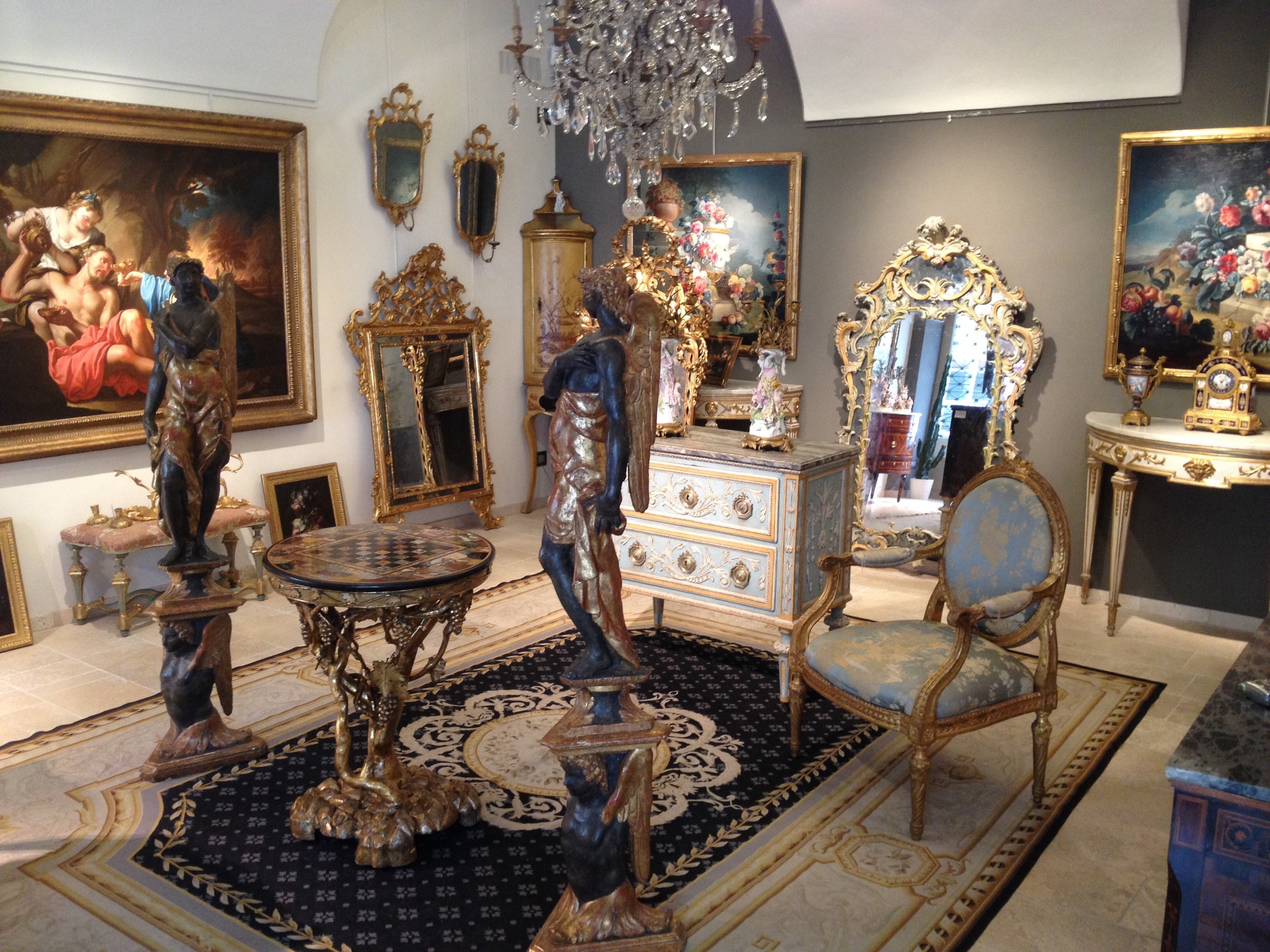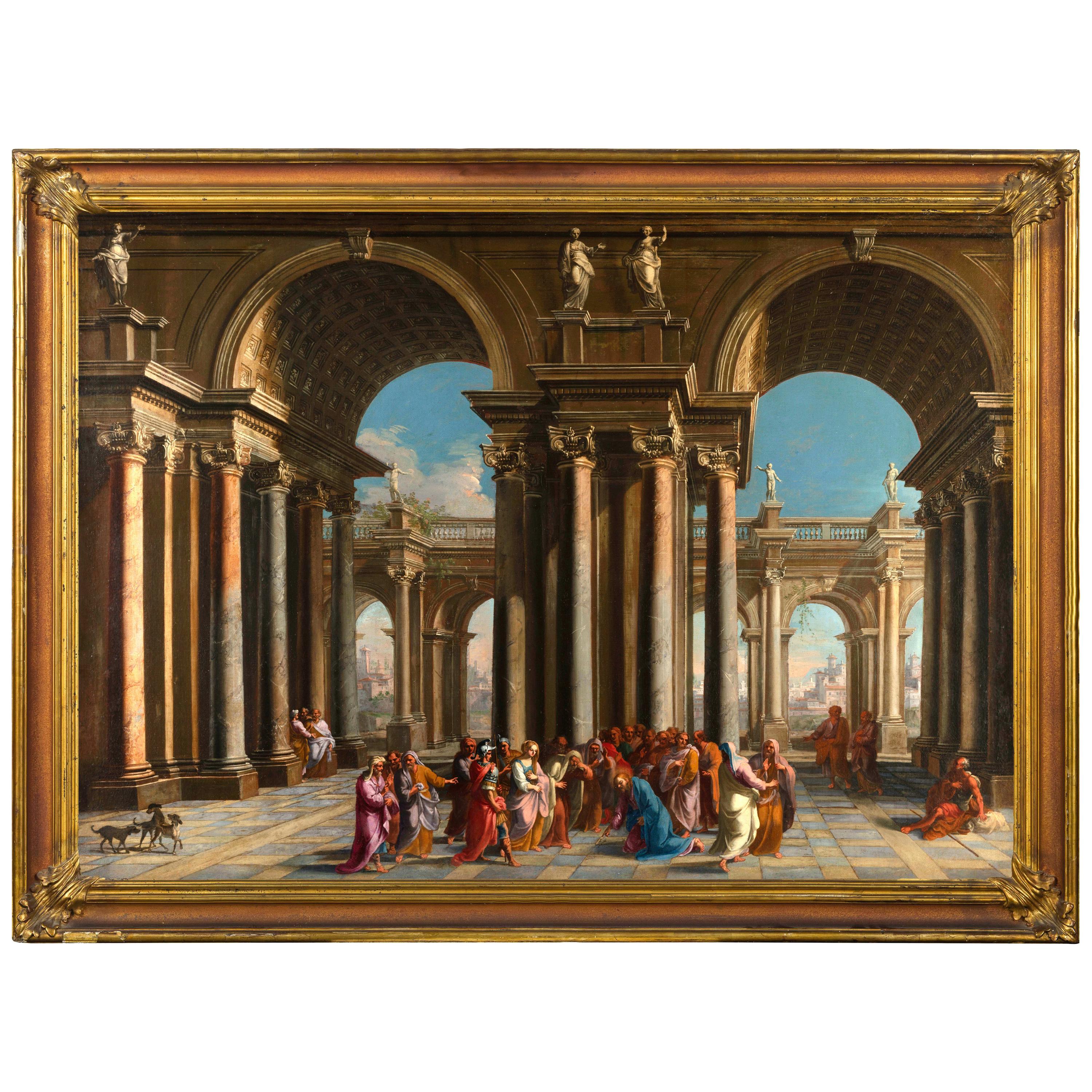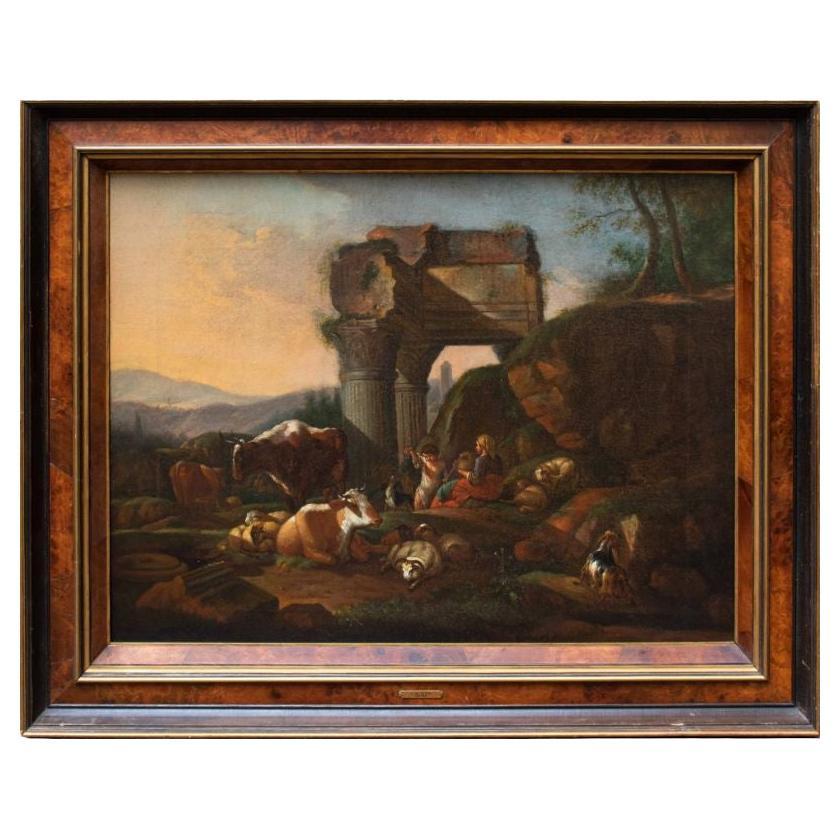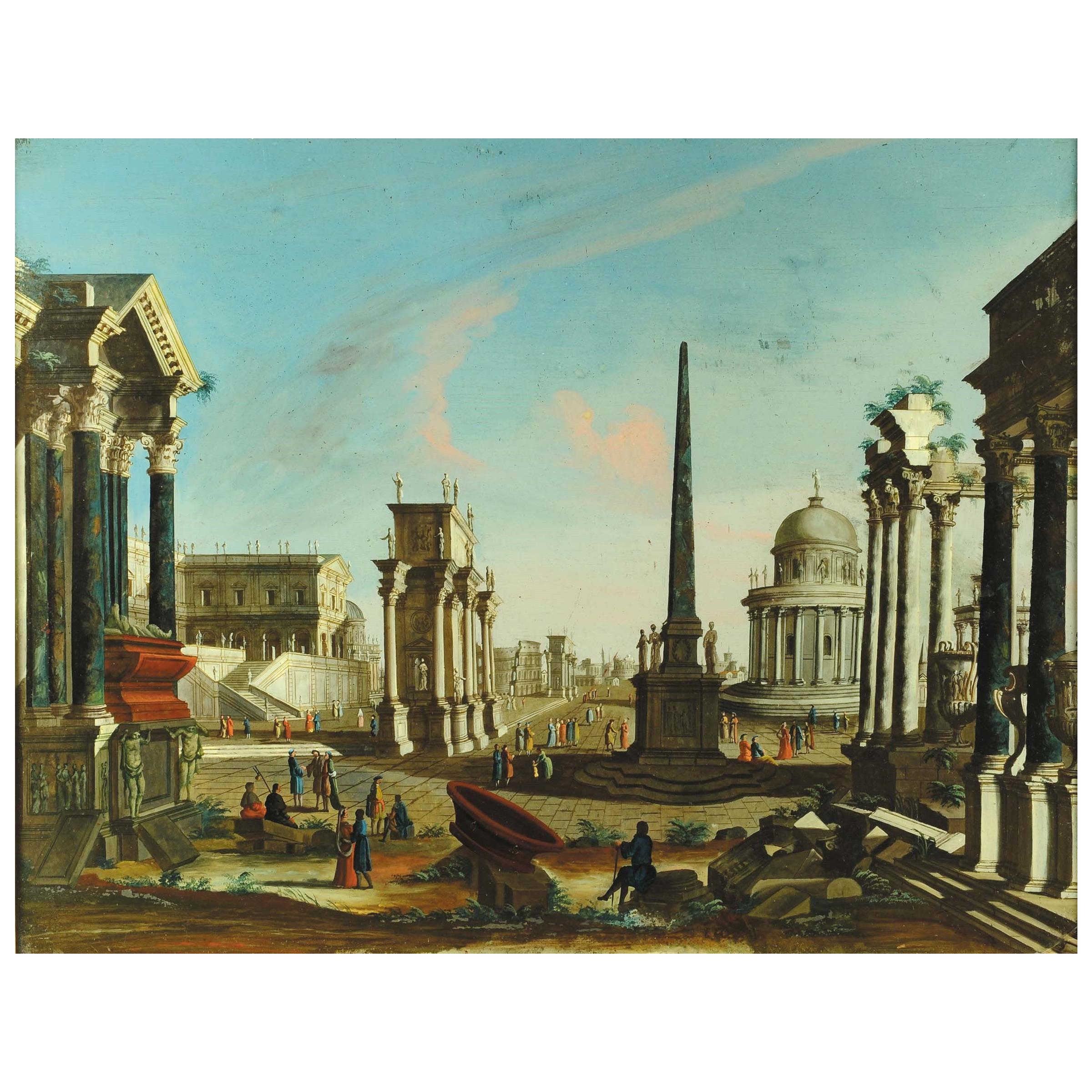Items Similar to Alberto Carlieri, Painting with Architectural Capriccio
Want more images or videos?
Request additional images or videos from the seller
1 of 9
Alberto Carlieri, Painting with Architectural Capriccio
About the Item
Alberto Carlieri (Rome 1672-1720)
"Architectural capriccio with the preaching of Saint Paul in the Areopagus of Athens"
Oil on canvas, measures with frame W 172 x H 127 x D 10,5 (only canvas cm W 135 x H 99)
The large and very interesting oil on canvas painting depicts an architectural capriccio with the preaching of Saint Paul in the Areopagus of Athens. The work is attributable to the famous Italian painter Alberto Carlieri (Rome 1672-1720).
The composition is characteristic of Carlieri’s artistic expression. The subject depicted, or The sermon of Saint Paul, is set among powerful architectural remains of fantasy, called «Architectural Capriccio». The architectural capriccio, an artistic genre that has made its way into Italian painting since the 17th century, is characterized by the representation of fantastic architectures or inventions of perspective type, sometimes combined with elements drawn freely from reality.
The canvas in question has a considerable artistic interest and significant pictorial quality. The spectacular architecture of invention gives solemn classicism to the place, amplified by the play of light and shadow, acting as a theater and as a frame to the scene.
In the foreground, a partially collapsed colonnade emerges from the shadow on the right, while on the left, there are piled on the ground parts of columns including a capital of the Corinthian order. The characters are in the middle of the canvas, in the background.
All around are described the remains of classical buildings, characterized by composite style, smooth columns, Corinthian capitals, trabeation with metopes and Doric friezes. On the right is a sepulchre and even beyond a large carved marble vase with bas-reliefs. To close the architectural environment there is a powerful building with an arch and large arche, bas-relief with Roman soldiers, pilasters and composite columns. Some greenery has sprung to its peak, giving picturesque features to the canvas. The landscape fades to the horizon where you can see a bay, the sea and a promontory described with blue tones. The clear blue sky is marked by pink grey fluffy clouds.
The scene described is Saint Paul’s Sermon in the Areopagus of Athens. Saint Paul is clearly recognizable by some elements that belong to his traditional iconography: depicted bald, with a long beard and elongated shape, he wears a green tunic with a red cloak and grips, here with his left hand, A sword with a point on the ground. The sword, a symbol of power, has a double interpretation: it alludes both to the take-off, or the martyrdom of Saint Paul, and to the power of faith and the proclamation of the divine word. In fact, Paul spoke to the Gentiles, the peoples of Greek-Latin culture, considered pagans by the Jews, of «the sword of the Spirit, that is, the word of God» (Eph. 6:17). The sword is a part of the spiritual armor that Paul says he should wear to allow him to effectively fight evil.
The scene is inspired by the time Paul makes a speech in Athens at the Areopagus (in Acts 17:16-34). It is one of the most dramatic and detailed moments of St Paul’s missionary career.
The Apostle had encountered opposition in his preaching at Thessalonica and at Berea in northern Greece and, between the end of 49 and the beginning of 50, he went to Athens to be safe. Distressed to see Athens full of idols, Paul goes to the Areopagus, the high tribunal of Athens, to explain what he claimed. " Areopagus" literally means "Rock of Ares"; it was a place where there were temples, cultural structures and it was the high court of the city. Paul’s speech is based on five main points: the ignorance of pagan worship; the object of worship is the one Creator God; God’s relationship with humanity; idols of gold, silver, and stone as objects of false worship; and in conclusion, it is time to put an end to ignorance. This discourse is one of the first attempts to explain the nature of Christ and is a first step in the path leading to the development of Christology.
The work, painted with great finesse also in the details and in the small figurines, is certainly attributable to the important Roman painter Alberto Carlieri (Rome, 1672 - 1720) because you can find common stylistic reasons of his works. Characteristic elements are the suggestive compositional arrangements and the remarkable mastery in the direction of the lights, as well as the richness of the architecture and the refined, as well as meticulous, descriptive details. Peculiar to the author is also the lively attitude of the figures, resolved with ease in the use of color, and inserted harmoniously in the architecture.
Carlieri was born in Rome in 1672 and began studying the painting of architecture under the guidance of Giuseppe de Marchis. He became a pupil and later collaborator of Andrea Pozzo. Present in the most illustrious Roman paintings, from the collection of Filippo II Colonna, Rospigliosi and Cardinal Valenti Gonzaga, Carlieri elaborates compositional models well recognizable, influenced, as well as by the painting of the master also that of Viviano and Nicolò Codazzi. His pictorial activity can be traced through the signed works, around which it was possible to build a not small catalogue of canvases. News of the Carlieri and his signed or dated works are between 1690 and 1720. Nothing is known about the life of the painter, who should have died in Rome shortly after 1720.
Among the studies on the Carlieri is significant what investigated by Marshall, and later reiterated by Giancarlo Sestieri, about the influence that Giovanni Ghisolfi (Milan 1623-1683) and Giovanni Paolo Panini (Piacenza 1691 - Rome 1765) had on the architecture of our painter. There are some attributive perplexities for certain works, historically given to Panini or Ghisolfi, which could instead be returned to Carlieri or vice versa. At the center of an attributive diatribe is the Capriccio with the preaching of an apostle preserved as Panini autograph at the Christian Museum of Esztergom in Hungary but which was also attributed to Ghisolfi or Carlieri himself, as proposed by Sestieri. Certainly our painter, especially in the paintings developed vertically, proposes numerous elements taken from the "Esztergom composizion", as is defined this compositional module in all its variants
These are compositions in which the great architectures are fragmentary; picturesque greenery partially cover them; architectural remains are piled on the ground; there is always an architectural detail with the trabeation of the colonnade interrupted; the perspective has a lateral escape from the composition; it is often set a scene depicting the preaching of Christ or a saint.
Carlieri uses this compositional scheme assiduously. We can also partially find it in the painting in question though it is developed horizontally.
In these paintings, and in general in the works of this artist, are often found some figures or objects that the author likes to insert with some small variations. Among these is the classic stone vase with female figures in bas-relief.
The same is true of the half-stretched character who holds his arm on the ground. This particular, very frequent and also depicted in a mirror way, can almost be considered a signature of Carlieri.
The author depicts several times the preaching of an apostle. As Sestieri points out, they had to be the subjects to lead the commissions of Carlieri. To some, therefore, it was more successful, according to their numerous versions, such as the «Parables» or the «Sermons» of Christ or the Apostles.
Some of the most significant examples have been compared in this study.
We apologize for any errors in translation from Italian.
Please, contact us to have the expertise in Italian.
- Attributed to:Alberto Carlieri (Artist)
- Dimensions:Height: 50.01 in (127 cm)Width: 67.72 in (172 cm)Depth: 4.34 in (11 cm)
- Style:Baroque (Of the Period)
- Materials and Techniques:
- Place of Origin:
- Period:Late 17th Century
- Date of Manufacture:Late 17th Century
- Condition:Refinished. The painting has been restored with a cleaning of the surface, removal of the yellowed varnish and repainting with transparent finish varnish.
- Seller Location:IT
- Reference Number:1stDibs: LU4405221483832

About the Seller
5.0
Platinum Seller
These expertly vetted sellers are 1stDibs' most experienced sellers and are rated highest by our customers.
Established in 1980
1stDibs seller since 2019
42 sales on 1stDibs
Typical response time: 2 hours
- ShippingRetrieving quote...Ships From: Italy
- Return PolicyA return for this item may be initiated within 7 days of delivery.
More From This SellerView All
- Alberto Carlieri, Capriccio with Christ and the Adulteress, Oil on CanvasBy Alberto CarlieriLocated in ITAlberto Carlieri (Italy-Roma 1672-1720), "Christ and the adulteress", Oil on canvas, with frame cm H 115 x L 151 x 6.5, only canvas H 98.5 x L 135 cm...Category
Antique Late 17th Century Italian Baroque Paintings
MaterialsCanvas
- 18th Century, Roman Architectural Capriccio Attributed to Francesco ChiarottiniLocated in ITFrancesco Chiarottini (1748-1796) Roman Architectural Capriccio Oil on glass, cm 52 x 67 without frame, 63.5 x 79cm with frame The valuable painting, attributed to the Italian p...Category
Antique Mid-18th Century Italian Neoclassical Paintings
MaterialsGlass
- 18th Century, French Painting with Landscape with RuinsLocated in IT18th century, French Painting with Landscape with Ruins Measures: frame cm L 165 x H 95 x P 10; canvas cm L 142 x H 71 This painting depicti...Category
Antique Late 18th Century French Baroque Paintings
MaterialsCanvas
- 19th Century, Italian Painting with Still Life with CherubsLocated in IT19th century Roman painter Still life with cherubs, flower festoons and herma with faun Measures: Oil on canvas, cm H 78 x W 95 without frame Cm H 122.00 x W 106 x D 8 with frame. The work, painted in oil on canvas, octagonal in shape, represents a nature with three putti or cupids playing with flower festoons in a wooded environment in which is placed a herma with faun and, on the left, a large neoclassical marble vase...Category
Antique 19th Century Italian Baroque Paintings
MaterialsCanvas
- 18th Century, Italian Oil on Canvas Painting with Landscape with RuinsLocated in IT18th century, Italian oil on canvas painting with landscape with ruins Measures: only the canvas cm W 97.5 x H 108; with the frame cm W 103.5 x H 114 x D 5 The fine oil on canv...Category
Antique 18th Century Italian Baroque Paintings
MaterialsCanvas
- 17th Century, Italian Painting with Saint Cecilia with Angels in ConcertLocated in IT17th century Roman school, Santa Cecilia with angels in concert, oil painting on canvas The valuable painting, in excellent condition, depicts Sa...Category
Antique 17th Century Italian Baroque Paintings
MaterialsCanvas
You May Also Like
- 17th Century Architectural Capriccio with Herds Painting Oil on CanvasLocated in Milan, ITCircle of Nicolaes Berchem (1620, Haarlem - 1683, Amsterdam) Architectural capriccio with herds Oil on canvas, 57.5 x 74 cm With frame 76 x 93 cm The examined canvas is...Category
Antique 17th Century Dutch Paintings
MaterialsCanvas
- Architectural Capriccio of Roman Ancient Ruins with FiguresLocated in Vero Beach, FLArchitectural Capriccio of Roman Ancient Ruins with Figures. Italian, 18th century large painting in oil on canvas is from the school of Giovan...Category
Antique 18th Century Italian Other Paintings
MaterialsCanvas
- 18th Century Oil on Canvas Italian Capriccio Painting of Architectural RuinsLocated in Los Angeles, CA18th-century Italian capriccio painting. Mounted in a beveled gilt wood frame, the oil on canvas painting depicts a dreamy expanse of Roman architec...Category
Antique 18th Century and Earlier Italian George II Paintings
MaterialsCanvas
- Painting by Alberto Ruiz VelaBy Alberto Ruiz VelaLocated in Palm Springs, CAPainting by Mexican born Alberto Ruiz Vela. He also worked in Illinois and California.Painting is signed in the lower left portion of painting. Painting measures 31" wide and 41" high.Category
Vintage 1960s American Paintings
- 18th Century Italian Baroque Landscape After Magnasco Large Capriccio with RuinsBy Alessandro Magnasco il LissandrinoLocated in Milan, ITA Baroque Capriccio with ruins and figures, an early 18th century Italian painting showing an imaginary landscape with roman ruins and figures, an antique oil on canvas Italian...Category
Antique Early 18th Century Italian Baroque Paintings
MaterialsCanvas, Plaster, Giltwood
- Vintage Italian Capriccio Framed Oil on Canvas Painting of Landscape With RuinsLocated in Elkhart, INA gorgeous Grand Tour style framed oil painting of an Italian Capriccio landscape with ruins Italy, Mid-20th Century Oil on canvas, gilt frame Measures: 9.5"W x 1"D x 9.5"H. Exce...Category
Mid-20th Century Italian Grand Tour Paintings
MaterialsPaint, Giltwood, Canvas
Recently Viewed
View AllMore Ways To Browse
Architectural Wall Details
Column Base Architectural
Large Baroque Painting
Dated 17th Century Furniture
Swords Decoration
Antique Christian Painting
Architectural Wall Columns
Painting Greek Roman
Architectural Building Parts
Antique Fantasy Furniture
Baroque Oil Painting Large
17th Century Reliefs
Italian Architectural Arches
Arch Wall Light
Baroque Christian
Alberto Master
Wall Light Greece
Wall Mirror With Arm





